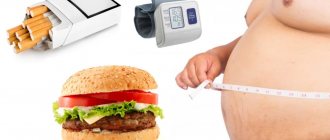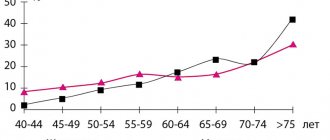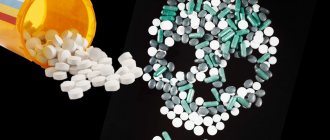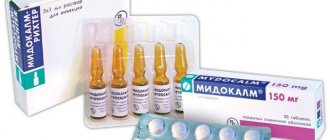Antispasmodics are a group of medications that can relieve spasms of internal organs and the associated pain syndrome.
Internal organs with a tubular structure (vessels, uterus, bronchi, ureters and bladder, intestines, bile ducts, etc.) contain a smooth muscle matrix - a layer of muscles located in the wall of the organ. Under physiological conditions, this smooth muscle regulates the lumen of the organ and is in constant tonic contraction.
Smooth muscle is involuntary. This means that we cannot control it using consciousness, such as striated muscles. We can voluntarily raise or lower our hand, but we cannot, through an effort of will, expand the bronchi or stop the contractions of the intestines. The smooth muscles are controlled by the autonomic nervous system. Autonomous because its functioning does not depend on our will.
The nerve endings of the autonomic nervous system do not adhere tightly to the smooth muscles; there is always a gap between them and the muscle, called a synapse. When the autonomic nerve is excited, under the influence of its impulse, a special substance called the mediator acetylcholine is released. This substance diffuses (penetrates) from the nerve ending to the muscle and activates the acetylcholine receptor on the smooth muscle cell membrane. At the same time, it is reduced. This is a normal physiological process.
In cases where the tone of the autonomic nervous system increases, for example, when the ureter is irritated by the spines of a kidney stone, more acetylcholine is produced, and the contraction of smooth muscles becomes excessively strong or chaotic. This leads to a painful sensation - spasm.
Spasm is a tonic, cramp-like contraction of internal organs that have smooth muscles and is manifested by specific pain. Spasm usually occurs due to inflammatory damage to the internal mucous membrane of a tubular organ.
During a spastic contraction of an organ, sensitive nerve endings and blood vessels are mechanically pinched, which leads to impaired circulation in the organ and pain. The pain syndrome caused by spasm is called colic.
Pharmacological action and its mechanism
Antispasmodic drugs can eliminate spasms through two mechanisms. The first mechanism is that the drug binds to the same receptor on smooth muscle as the neurotransmitter acetylcholine, but does not activate the receptor, but blocks it by simply occupying the acetylcholine site. The excess amount of acetylcholine cannot interact with its receptors, and the smooth muscle relaxes. This action is a neurotropic antispasmodic effect. Neurotropic because it affects the autonomic nervous system, making its activity ineffective.
The second mechanism by which antispasmodics can act is through the penetration of the drug into the smooth muscle cell, which changes its contractile physiology and makes its contraction ineffective. In this case, an antispasmodic effect will develop. This type of action is called the myotropic antispasmodic effect of gr. myos muscle and thropos direction of action.
Antispasmodics are classified according to the mechanism of action indicated above, since the mechanism of action is associated with well-predicted therapeutic and side effects.
Basics of therapy and application features
Not all antispasmodics have the same effect on certain organs. Some of them act predominantly on smooth muscles in some organs, and have no or almost no effect on smooth muscles in other organs. This selectivity of action is called selectivity.
For example, atropine, belladonna extract, papaverine and drotaverine, universal antispasmodics, bendazole acts primarily on blood vessels, theophylline primarily on the bronchi, mebeverine and prifinium bromide primarily on the organs of the gastrointestinal tract. Depending on the direction of action of the antispasmodic, it is prescribed for a particular pathology.
Neurotropic and myotropic antispasmodics, despite the fact that both relieve spasms of internal organs, they have common positive and negative aspects. For example, neurotropic antispasmodics cause dry mucous membranes and may cause constipation. Myotropic antispasmodics do not have such side effects, but they dilate blood vessels and lower blood pressure. Because of this, they are prescribed with caution to people with low blood pressure, or they may be contraindicated for them. Patients receiving medications for high blood pressure may require dose adjustment of antihypertensive drugs when prescribed a myotropic antispasmodic. Neurotropic antispasmodics do not have such disadvantages.
A positive feature of antispasmodics is their inability to mask threatening symptoms in the abdominal area, unlike analgesics. This means that if there is a serious pathology of the abdominal cavity, for example, inflammation of the peritoneum, the use of an antispasmodic will not mask this condition. The pain will persist despite the use of an antispasmodic. In this case, it is necessary to urgently seek medical help.
In any case, antispasmodic drugs can only be used after consulting a doctor, or if the drug is over-the-counter, after consulting a pharmacist.
Myotropic antispasmodics (MS) are a large group of drugs with diverse mechanisms of action that mediate their direct effect on smooth muscle cells. The modern classification of MS is as follows [13]:
I. Non-selective MS
- Phosphodiesterase inhibitors:
- isoquinoline derivatives (papaverine, drotaverine);
- xanthine derivatives (theophylline, aminophylline);
- various (bencyclane, pinaveria bromide, adiphenine, arpenal, etc.).
II.Selective MS
- Calcium channel inhibitors:
- phenylanylamine derivatives (verapamil);
- benzothiazepine derivatives (diltiazem);
- dihydropyridine derivatives (nifedipine, nitrendipine).
- Potassium channel activators (minoxidil, diazoxide).
- Nitric oxide donors (sodium nitroprusside, nitroglycerin, etc.).
This review is devoted to various aspects of the clinical use of non-selective MS (NSMS), which continue to be quite widely used in modern medical practice to reduce tone and relax smooth muscles.
The action of NMS is realized through the regulation of biochemical processes directly in smooth muscle cells and, as a rule, does not affect ion channels [8]. In past years, NMS were actively used for the treatment of arterial hypertension, but the appearance on the market of angiotensin-converting enzyme inhibitors, angiotensin receptor antagonists, calcium channel blockers of the latest generation and other drugs that can not only effectively reduce blood pressure, but also improve the quality of life of patients, sharply limited the use of NMS for this indication. In addition to the relatively low antihypertensive effectiveness of NMS, vascular dilatation caused by NMS, often leading to the development of compensatory tachycardia, played an important role here. However, drugs of this class continue to be widely used in the treatment of arterial hypertension in pregnant women, for whom most NMS are relatively safe. In addition, during pregnancy, we are usually not talking about the treatment of severe organic pathology, but about the treatment of temporal conditions caused by trophoblast [4]. According to a population study, in the Russian Federation, papaverine and other NMCs belong to the group of drugs most often used to treat arterial hypertension during pregnancy [12].
However, from the point of view of their clinical use, the antihypertensive effect of NMS fades into the background. Currently, their main advantage is considered to be the ability to effectively eliminate spastic contractions (spasms) of smooth muscles, restoring the normal functioning of smooth muscle organs and suppressing pain. Most often, NMS are used to treat vasospasms, and somewhat less often - to eliminate spasms of other smooth muscle organs (intestines, biliary tract, uterus, etc.).
A multicenter, randomized, placebo-controlled study examined different treatments for pain caused by spastic smooth muscle activity. It has been demonstrated that NMJs are superior to analgesic drugs in their analgesic effectiveness. In patients taking NMS, improvement was noted already by the 4th day of treatment, and in those receiving analgesics - only by 7-10 days. In addition, the cost of NMS treatment turned out to be significantly lower than analgesic therapy [16].
Until recently, the antispastic activity of NMS was questioned, and only in recent years has it been possible to obtain direct and indirect evidence of the antispastic effects of drugs in this group.
Thus, in a study by Arquilla et al. (2000) found that intravenous administration of chlordisapoxide to young people with alcohol withdrawal can lead to limb ischemia due to the development of vasospasm. The authors visualized the state of the vessels angiographically and showed that intra-arterial administration of papaverine effectively relieved spasm, while calcium channel blockers and placebo did not have a similar effect [15].
The method of thoracic rheovasography has proven the ability of drotaverine (No-shpa, No-shpa forte, Spazmol), which is a synthetic analogue of the opium alkaloid papaverine, to increase cardiac index and reduce peripheral vascular resistance in patients with stable angina (functional class II-III according to NYHA) compared with placebo [3].
A randomized, placebo-controlled trial demonstrated that benzinclan (Halidor) for 10 weeks reduced cerebral arterial occlusion, with an effect comparable to that of buflomedil [26].
Placebo-uncontrolled studies that used tetrapolar rheography showed that drotaverine eliminates vasospasm and normalizes central and regional hemodynamics [3]. Similar effects of drotaveril [23], adiphenine [22], arpenal [9, 10], and magnesium sulfate [17] have been demonstrated in other studies. There is evidence that the vasodilating effect of drotaverine is comparable to that of dipyridamole [6].
Confirmation of the vasodilating effect of NMS served as the basis for studying the effectiveness of the use of these drugs in the treatment of vascular diseases associated with increased contractile activity of the smooth muscles of the vascular wall. Thus, in particular, a comparative study of drotaverine and pentoxifylline (Trental) was conducted in patients with cerebral and peripheral vascular diseases. As it turned out, in addition to vasodilation, both drugs reduced blood viscosity, platelet aggregation and prevented thrombus formation. Pentoxifylline was approximately 3 times more effective than drotaverine [20].
Unfortunately, according to the meta-analysis, to date only 22 placebo-controlled studies have been conducted to assess the effect of NMS on cerebral hemodynamics. At the same time, poor documentation of the studies, non-representativeness of the groups, lack of comparative studies, and inconsistency of the results obtained when using similar test protocols were noted. Only 3 studies had comparable patient groups and treatment regimens. Thus, despite the discovered positive effects of NMS, it is somewhat premature to talk about fully proven clinical effectiveness of drugs in this group for spastic disorders of cerebral hemodynamics [24].
In addition to studying the effect of NMS on blood vessels, their effect on the smooth muscles of other organs was also assessed. The antispastic activity of NMS in relation to smooth muscle cells of the gastrointestinal tract was confirmed in clinical trials on volunteers. In particular, when studying the large intestine using the double contrast method with a barium enema, it was found that NMS accelerate the excretion of barium, and this effect is comparable to that of glucagon [18].
A multicenter, placebo-controlled study assessed the effectiveness of NMS in spastic esophageal obstruction caused by foreign bodies. NMJs have been shown to be more effective in relieving esophageal smooth muscle spasm than glucagon and placebo [25].
Interesting data were obtained in a randomized, double-blind, placebo-controlled study examining the effectiveness of various treatment regimens for irritable bowel syndrome. When sulpiride was prescribed as monotherapy (200-450 mg/day, 6 weeks), a positive therapeutic effect (disappearance of abdominal symptoms, anxiety, depression, normalization of stool) was observed in only 10% of patients, and with the combined use of sulpiride and NMS - in 85% patients [7].
Another randomized, placebo-controlled trial compared five treatments for irritable bowel syndrome and found placebo to be ineffective. The effectiveness of acupuncture and pseudoacupuncture was 31% and 17.2%, respectively. Psychotherapy had a positive effect on 17.2% of patients. A positive effect of papaverine was observed in 74% of patients [21].
Another NMS, otilonium bromide (Spasmomen), has been shown to have selective antispasmodic activity against smooth muscle cells of the gastrointestinal tract. A meta-analysis found that this drug has a pronounced inhibitory effect on spontaneous and induced gastric and intestinal motility. Otilonium bromide has been proven effective in the treatment of irritable bowel syndrome and biliary spasms. The drug has a wide therapeutic range, accumulates mainly in the intestines and practically does not enter the systemic circulation (about 5% of the dose is absorbed when taken orally). At the same time, otilonium bromide does not affect the acid-forming function of the stomach, which is a characteristic side effect of atropine [19]. In addition to spastic conditions and dyskinesia of the gastrointestinal tract, the indication for the use of otilonium bromide is preparation for endoscopic examinations. Pinaveria bromide (Dicetal), used for similar indications, has similar pharmacological properties.
NMS are widely used to treat spastic contractions of the biliary tract, however, for most drugs in this class, there is no objective data on the effectiveness of use. The exceptions are drotaverine and phenicaberan. It is known that patients with viral hepatitis experience spastic biliary dyskinesia. Therapy with drotaverine and phenicaberan made it possible to eliminate not only spasm, but also dyskinesia [1].
It is important to note that some NMJs have analgesic effects unrelated to their antispastic activity [14]. Thus, the pronounced analgesic effect of drotaverine was manifested during surgical operations. The combination of metamizole sodium (Analgin), diazepam and drotaverine was comparable in analgesic activity to promedol [2]. In an experiment on animals, drotaverine was superior in analgesic activity to metamizole sodium [11].
Concluding this review, I would like to emphasize that while the number of large randomized clinical trials assessing the effectiveness of NMS is very small, systematic studies on this problem are practically absent. Most of the work performed is empirical in nature and includes an insufficient number of patients. The mechanisms of action of many NMS remain poorly understood. Exceptions are papaverine and drotaverine, whose action is now established to be based on inhibition of phosphodiesterase and stabilization of intracellular cAMP levels. Due to the fact that cAMP is a Ca++ antagonist, these NMJs prevent the entry of Ca++ into cells and their contraction [23]. However, publications in recent years indicate continued interest in NMS. This allows us to hope that large-scale studies of their effectiveness will be conducted in the near future in accordance with the requirements of Evidence Based Medicine.






